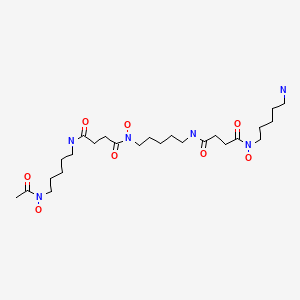Attribution Statement: LactMed is a registered trademark of the U.S. Department of Health and Human Services.
NCBI Bookshelf. A service of the National Library of Medicine, National Institutes of Health.
Drugs and Lactation Database (LactMed®) [Internet]. Bethesda (MD): National Institute of Child Health and Human Development; 2006-.
CASRN: 70-51-9

Drug Levels and Effects
Summary of Use during Lactation
Deferoxamine is poorly absorbed orally, so it is not likely to reach the bloodstream of the infant or cause any adverse effects in breastfed infants.[1] Limited information indicates that maternal doses of deferoxamine up to 2 grams daily do not affect iron levels in breastmilk and did not cause any adverse effects in two breastfed infants.[2] Some experts advocate breastfeeding in women receiving deferoxamine for iron overload caused by beta-thalassemia.[3] However, since little published information is available on the use of deferoxamine during breastfeeding, monitoring of the infant's serum iron is recommended.
Drug Levels
Maternal Levels. A woman with beta-thalassemia restarted deferoxamine 2 grams subcutaneously daily for 5 days per week 3 days after delivery. Milk was collected on days 5 and 9 postpartum and 11 weeks postpartum. Iron levels in milk were 0.7, 10.4 and 4.8 micromoles/L, respectively (normal range 7.7 to 22.4 micromoles/L).[2]
Infant Levels. Relevant published information was not found as of the revision date.
Effects in Breastfed Infants
A woman with beta-thalassemia restarted deferoxamine 2 grams subcutaneously 5 days per week 3 days after delivery. She breastfed (extent not stated) one of her twins from birth. After 17 days of breastfeeding, the infant's serum levels were as follows: iron 17.4 micromoles/L, ferritin 200 mcg/L, and transferrin16.8 micromoles/L, all in the normal range. Serum urea, calcium and magnesium were also normal. The second twin was hospitalized for longer and breastfeeding status in the hospital was not reported. Both infants were breastfed (extent not stated) for 4 months postpartum. Both had normal neurologic and motor development at 4 months and laboratory values consistent with their heterozygous beta-thalassemia: hemoglobin F 11.1% and 8.4%, hemoglobin 10.5 g/L and 10.5 g/L, reticulocytes 3.3% and 2.6%, and median erythrocyte volume 60 fL and 58 fL. Their serum levels of iron, ferritin, transferrin, liver enzymes, plasma urea and bilirubin were all normal.[2]
A woman with beta-thalassemia gave birth to an infant by cesarean section and breastfed her infant (extent not stated) from birth while receiving deferoxamine (dosage not stated). No adverse effects were reported in her infant.[3]
Effects on Lactation and Breastmilk
Relevant published information was not found as of the revision date.
Alternate Drugs to Consider
References
- 1.
- Jensen CE, Tuck SM, Wonke B. Fertility in beta thalassaemia major: a report of 16 pregnancies, preconceptual evaluation and a review of the literature. Br J Obstet Gynaecol. 1995;102:625–9. [PubMed: 7654640]
- 2.
- Surbek DV, Glanzmann R, Nars PW, et al. Pregnancy and lactation in homozygous beta-thalassemia major. J Perinat Med. 1998;26:240–3. [PubMed: 9773387]
- 3.
- Pafumi C, Zizza G, Caruso S, et al. Pregnancy outcome of a transfusion-dependent thalassemic woman. Ann Hematol. 2000;79:571–3. [PubMed: 11100748]
Substance Identification
Substance Name
Deferoxamine
CAS Registry Number
70-51-9
Disclaimer: Information presented in this database is not meant as a substitute for professional judgment. You should consult your healthcare provider for breastfeeding advice related to your particular situation. The U.S. government does not warrant or assume any liability or responsibility for the accuracy or completeness of the information on this Site.
- User and Medical Advice Disclaimer
- Drugs and Lactation Database (LactMed) - Record Format
- LactMed - Database Creation and Peer Review Process
- Fact Sheet. Drugs and Lactation Database (LactMed)
- Drugs and Lactation Database (LactMed) - Glossary
- LactMed Selected References
- Drugs and Lactation Database (LactMed) - About Dietary Supplements
- Breastfeeding Links
- PubChem SubstanceRelated PubChem Substances
- PubMedLinks to PubMed
- Review Iohexol.[Drugs and Lactation Database (...]Review Iohexol.. Drugs and Lactation Database (LactMed®). 2006
- Review Ioxaglate.[Drugs and Lactation Database (...]Review Ioxaglate.. Drugs and Lactation Database (LactMed®). 2006
- Review Iopamidol.[Drugs and Lactation Database (...]Review Iopamidol.. Drugs and Lactation Database (LactMed®). 2006
- Review Iopromide.[Drugs and Lactation Database (...]Review Iopromide.. Drugs and Lactation Database (LactMed®). 2006
- Review Iodixanol.[Drugs and Lactation Database (...]Review Iodixanol.. Drugs and Lactation Database (LactMed®). 2006
- Deferoxamine - Drugs and Lactation Database (LactMed®)Deferoxamine - Drugs and Lactation Database (LactMed®)
Your browsing activity is empty.
Activity recording is turned off.
See more...
